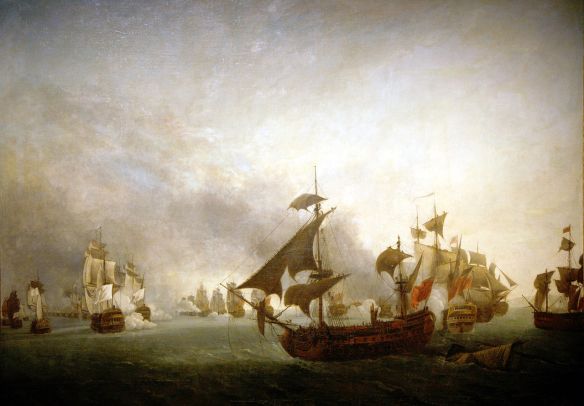Battle of Grenada, by Jean-François Hue.
The stifling effect of a system of command reliant on visual signals was also evident at the July 1779 battle of Grenada. After d’Estaing’s failure at Rhode Island, he retired to Boston and refitted his fleet before sailing in November to the West Indies, where French forces had already captured Dominica. The arrival there of his powerful French squadron placed the British on the defensive, though at first they weathered the storm. In December the British captured St. Lucia, where a well-handled British squadron of seven ships commanded by Rear Admiral Sir Samuel Barrington fended off d’Estaing’s dozen of the line, while ashore the island’s garrison repulsed a French counterattack. Not until the spring of 1779 did the French achieve any marked successes. In June d’Estaing learned that the British fleet, now commanded by Vice Admiral Sir John Byron, had escorted a convoy northward. The French sailed from their anchorage at Martinique and landed a small force that captured St. Vincent. Emboldened by his victory, and reinforced by the arrival of a squadron from Brest, d’Estaing led his fleet and transports farther south to attack Barbados, but because of contrary winds decided to strike at Grenada instead. When Byron learned that the French were out, he raced south, but too late to intercept. Informed that the enemy had landed a force on Grenada, Byron sailed on, encumbered by his own convoy of transports, in an effort to relieve the besieged garrison of Georgetown. On the morning of 6 July he surprised the French at anchor in St. George’s Bay.
Byron ordered a general chase, although his twenty ships of the line were in a somewhat ragged order and three of the liners had been detached to protect the convoy because of his shortage of frigates. Sensing that he had a chance to trap and destroy d’Estaing’s sixteen ships in the harbor, he was intent on bringing on an engagement.
Unfortunately for Byron, he was operating under three critical misconceptions. Georgetown had already fallen, and the town’s fort and cannon were in French, not British hands. D’Estaing commanded not sixteen but twenty-four ships of the line. Worse yet, the French fleet, though a picture of disorder in the harbor, responded with unusual and, to Byron, surprising celerity as the able and aggressive Suffren led the van out of the harbor. By the time Byron recognized that he had arrived too late, was outnumbered, and had failed to trap the French, his leading ships were in trouble. He signaled for the disordered fleet to reverse course, and ultimately to form into a line, though to continue to engage closely. There followed some desperate fighting, but by midafternoon Byron’s fleet was clearly beaten.
The French had won the battle; the initiative lay with d’Estaing. As the two fleets sailed toward the northeast, Byron feared that the longer French line might double his own or that d’Estaing might detach his frigates and send them after the British convoy. From his flagship, d’Estaing surveyed the situation and at 1545 signaled for his fleet to tack and to sail back toward St. George’s Bay. Three British ships of the line, heavily damaged earlier in the day, lay directly in the path of the French fleet, but, to the astonishment of many in both commands, d’Estaing’s men-of-war sailed by, content to exchange a few desultory broadsides before returning to the bay without having taken as much as a prize.
Grenada is of interest in part because Byron departed the line, lost the battle, and suffered neither execution nor court-martial: so much for any stultifying effect. Byron, believing he had caught an inferior and disordered fleet at anchor, promptly attacked. He failed because of inaccurate intelligence and an unusually quick French reaction. The British, despite their positional and numerical disadvantage, performed fairly well. They suffered about six hundred casualties; the French nearly a thousand. And although Byron had thrown out Howe’s signal book and resurrected the old fighting instructions, the divisions and ships of the fleet cooperated better than had Keppel’s at Ushant, or would Howe’s at the Glorious First of June in 1794. At a critical stage of the battle of Grenada, as Byron’s fleet wore (brought its stern across the direction of the wind) and reversed course as it tried to re-form, a gap opened between Barrington’s van and the center. Rear Admiral Joshua Rowley, commanding the liners with the convoy, “saw Barrington’s three ships unduly separated and doubtless visibly mauled. Instead, therefore, of blindly following his leader, he cut straight across to the head of the column to support the van,—an act almost absolutely identical with that which won Nelson renown at Cape St. Vincent. In this he was followed by the Monmouth, 64, [from Rear Admiral Hyde Parker’s rear division] the brilliancy of whose bearing was so conspicuous to the two fleets that it is said that French officers after the battle toasted ‘the little black ship.’”
One could portray d’Estaing’s inability to make the most of the victory to his refusal to depart the line ahead. But the factors that constrained d’Estaing were not to be found in the realm of French tactics, but in that of operations and strategy. French admirals sought not victory over their opponent’s fleet in a quest for control or command of the seas, but support for a successful operation ashore. D’Estaing’s problem was not an overly strict adherence to the line, but his unwillingness to risk the sole prize he had to show for his efforts in American waters—Grenada.
